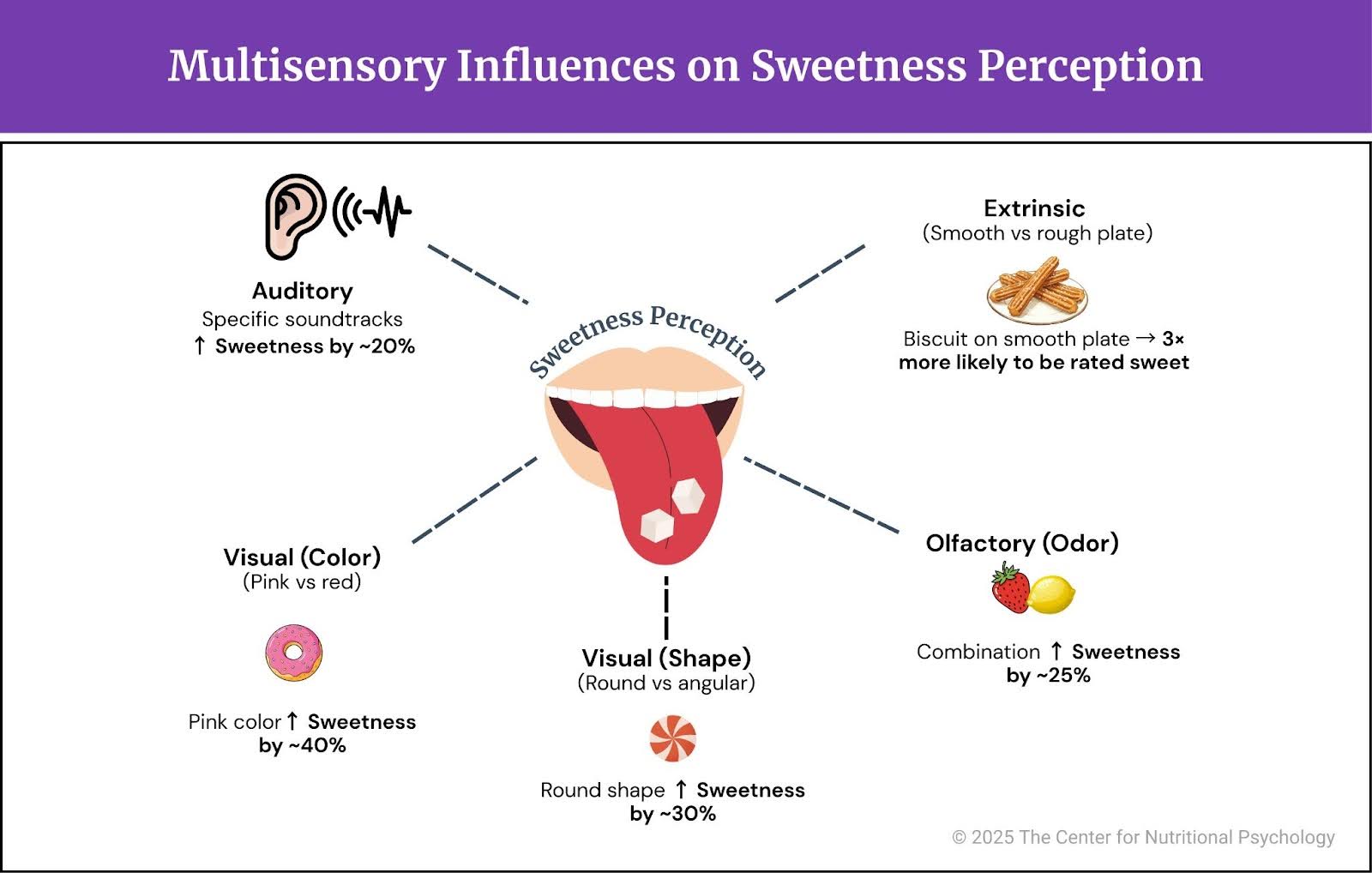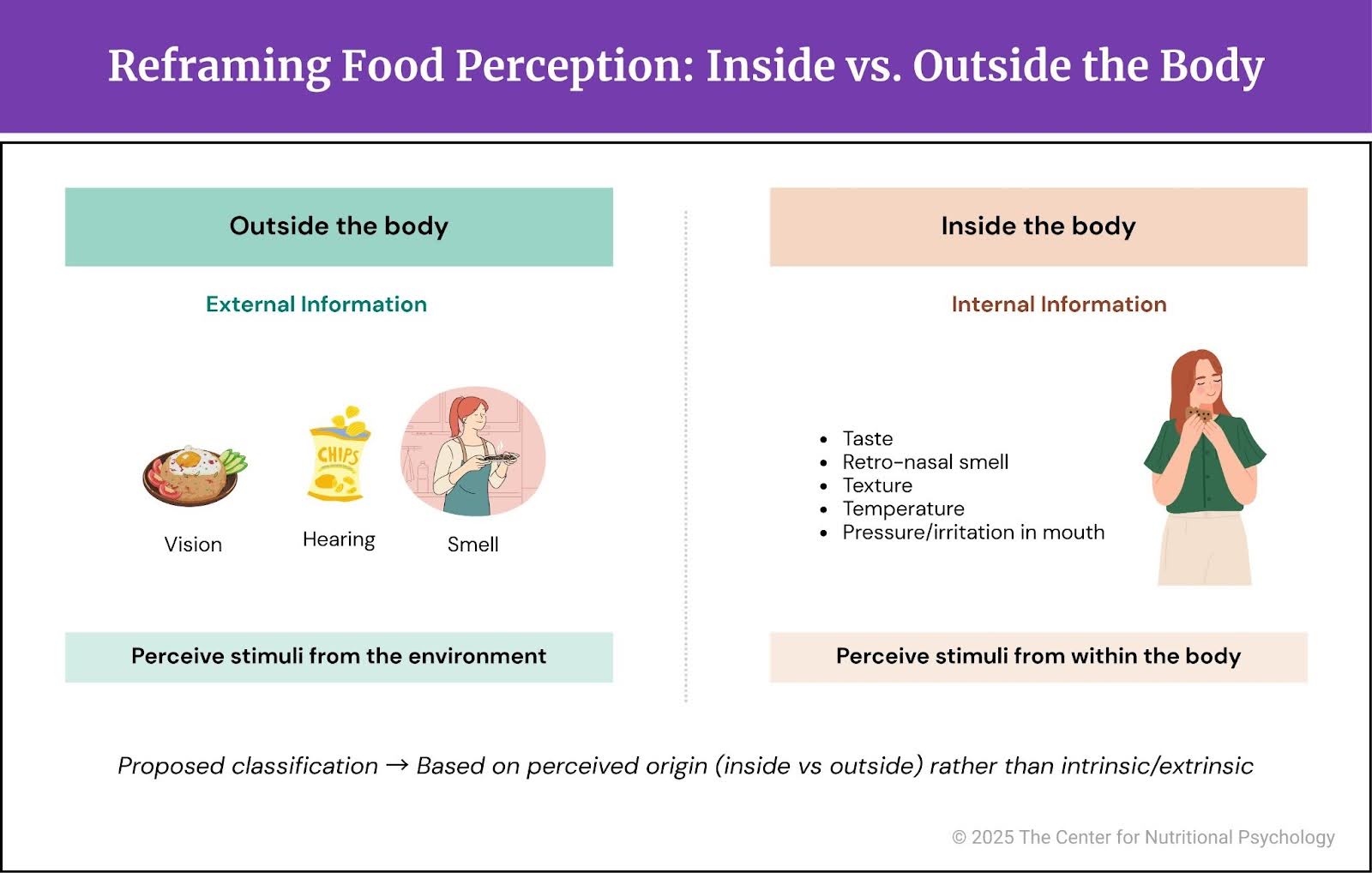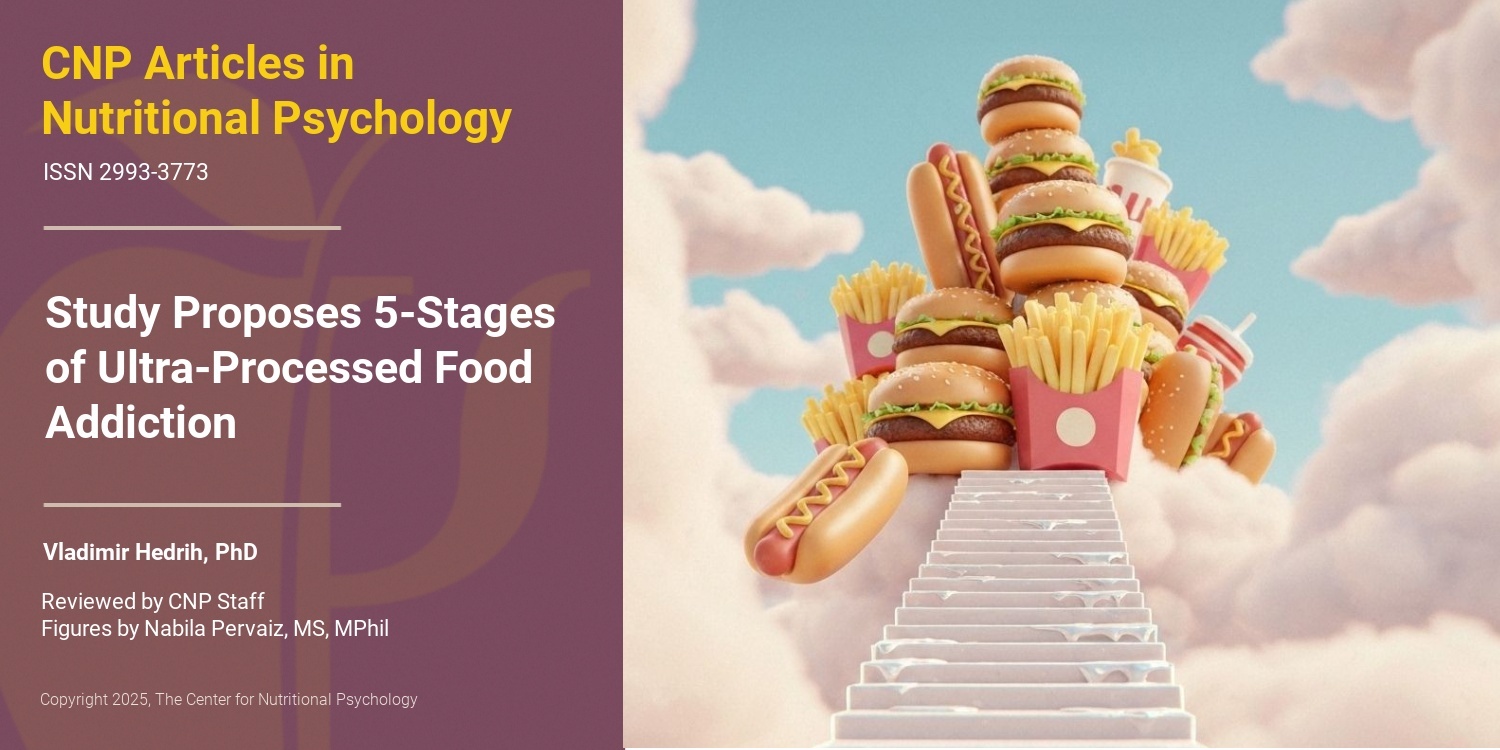A New Framework for Analyzing Food Flavor Perception

Listen to this Article
- A review paper published in Foods proposed a new framework for analyzing flavor perception, focusing on sweetness
- The framework is based on whether sensory information is seen as originating from within or from outside the body of the person perceiving the food.
- It discusses how intrinsic and extrinsic influences on the perception of flavor can be integrated and ends with recommendations for the food industry and future research
Although humans need nutrients from food to survive, the nutritional value of a food item is most often not the primary determinant of whether a person will consume a food item or not. There are very nutritious foods that many people will not eat (for example, some types of vegetables and anything that tastes or smells unpleasant). There are also many types of edible items that people readily consume, although they have no nutritional value (e.g., 0-calorie drinks with artificial sweeteners and flavors) or are even harmful. A prime example of the harmful items people readily consume is sugar-sweetened beverages, such as soft drinks. Although their high intake is firmly associated with a higher likelihood of obesity, type 2 diabetes, cardiovascular disease, and even depression, people around the world readily consume them (Hedrih, 2023; Huang et al., 2023).
Although their high intake is firmly associated with a higher likelihood of poor health, people worldwide readily consume them.
Food and Beverage Flavor Perception
When people casually think about the consumption of food and beverages, taste and smell usually come to mind first, as the most important or even the sole important qualities. However, eating and drinking are amongst the most multisensory experiences that people have. A growing body of research over the past two decades has demonstrated that all human senses, to varying degrees, contribute to flavor perception (Wang et al., 2019).
All human senses contribute to the perception of flavor.
For example, a recent study showed that individuals tend to report that food tastes better when it is offered to them in a more aesthetically pleasing environment (Wu et al., 2022). Another study indicated that when a restaurant plays music that the patrons like, they will spend more time and money at the restaurant. Spending more money is associated with eating or drinking more, indirectly suggesting that individuals likely enjoyed the food and beverages in the restaurant more (Caldwell & Hibbert, 2002). A 2003 study found that people find identically prepared dishes more acceptable when served in an upscale restaurant than when served in an institutional setting, such as a residential home for the elderly (Edwards et al., 2003). This review compiles numerous studies that investigate the sweetness-enhancing effects of various factors, including food color and the shape of the plate on which it is served (Wang et al., 2019). And there are many more.
Extrinsic and Intrinsic Factors of Food Flavor Perception
Researchers suggest that factors that influence the perception of food flavor can be divided into two categories: food-intrinsic sensory factors and food-extrinsic sensory factors. In simple words, food-intrinsic sensory factors are characteristics of the food item that human senses can perceive. These include the color, texture, viscosity, and other characteristics of the food product. Of course, the taste and smell of the food item are the core food-intrinsic factors in most cases.
How External Factors Affect Perception
Food-extrinsic factors are influences on how people perceive and evaluate a food item that come from outside the food itself. Food-extrinsic factors encompass food packaging, labeling, branding, the price of the food item, cultural associations and meanings associated with the food item, background music, temperature, the overall context or environment in which the food is consumed, and many other factors (Wang et al., 2019). In many cases, the smell and texture of the food packaging can also influence the perception of the food inside.
Cultural Influences on Food Perception
There are also food items that are integral to the identity of social groups. Hence, members of those groups perceive them positively and consume them even when some of them have very unacceptable food-intrinsic properties, such as a very pungent smell. Probably one of the most famous examples of this is surströmming — a Swedish traditional dish of fermented Baltic herring (Nygaard, 2019). This dish is notorious for its extremely pungent smell, often described as one of the strongest food odors in the world.
The Review: Integrating Intrinsic and Extrinsic Factors
Study author Qian Janice Wang and her colleagues note that the scientific knowledge of food-intrinsic and food-extrinsic flavor perception factors is clearly advancing. However, what remains less clear is how different factors interact and the importance of both intrinsic and extrinsic factors in the perception of foods and drinks, as well as in people’s behavior towards those foods and beverages (Wang et al., 2019).
They focused their review on the perception of sweetness. These authors note that the consumption of sweet foods (and particularly the excessive consumption of sugar) is one of the major contributors to the ongoing obesity pandemic (Wang et al., 2019; Wong et al., 2022) and the adverse health consequences it produces (Huang et al., 2023). Having an integrated model of sweetness perception could be helpful in reducing excessive intake, enabling many individuals to improve or protect their health.
Factors Influencing Sweetness Perception
The review provides an extensive list of studies that examined factors influencing the perception of sweetness, dividing them by the sense they activate. This list shows that specific soundtracks (music or sound effects) can enhance the perception of sweetness (up to 20%), but that certain colors can have the same effect. The strongest effect was reported for the pink color, with a 40% reported enhancement, while the red color most often did not affect sweetness perception. The round shape also enhanced the perception of sweetness (30%). Similarly, a combination of strawberry and lemon odor was reported to enhance sweetness perception by 25%. Considering extrinsic factors, the review cites a study that found biscuits served on a smooth plate to be three times more likely to be rated as sweet compared to those on a rough plate (see Figure 1).

Figure 1. Multisensory Influences on Sweetness Perception
A New Framework: Inside vs. Outside the Body
In the end, these authors propose that factors influencing the perception of food should not be categorized into extrinsic and intrinsic, but rather by whether an individual perceives the sensory information to originate from within or outside his/her body. In that regard, human senses can be divided into those that inform us about developments outside our bodies (vision, hearing, smelling through the nose) and those informing us about stimuli inside our bodies (taste, smell of odors inside the mouth, the perception of texture, temperature, pressure, and irritation in the mouth) (see Figure 2).

Figure 2. Reframing Food Perception: Inside vs. Outside the Body
Understanding Oral Referral in Flavor Perception
A person receives information about food from outside the body before eating, while the information from the inside comes during the process of eating. Different brain mechanisms are likely involved in processing these two types of sensory information. Review authors particularly note the phenomenon of oral referral – human perception that flavors originate in the mouth, even when they do not (as the critical sensory input for flavor comes from the nose).
Authors particularly note the phenomenon of oral referral – human perception that flavors originate in the mouth, even when they do not.
Conclusion
This review proposed a new framework for analyzing the effects of various influences on food perception. It emphasizes the distinction between the perception of whether the perceived stimuli originate from outside or inside the body of the person perceiving the flavor. This framework can be utilized by food producers and researchers to optimally balance the intrinsic and extrinsic characteristics of food products, thereby optimizing the perception of sweetness.
The paper “The Role of Intrinsic and Extrinsic Sensory Factors in Sweetness Perception of Food and Beverages: A Review” was authored by Qian Janice Wang, Line Ahm Mielby, Jonas Yde Junge, Anne Sjoerup Bertelsen, Ulla Kidmose, Charles Spence, and Derek Victor Byrne.
References
Caldwell, C., & Hibbert, S. A. (2002). The influence of music tempo and musical preference on restaurant patrons’ behavior. Psychology & Marketing, 19(11), 895–917. https://doi.org/10.1002/mar.10043
Edwards, J. S. A., Meiselman, H. L., Edwards, A., & Lesher, L. (2003). The influence of eating location on the acceptability of identically prepared foods. Food Quality and Preference, 14(8), 647–652. https://doi.org/10.1016/S0950-3293(02)00189-1
Hedrih, V. (2023, June 6). Health Consequences of High Sugar Consumption. CNP Articles in Nutritional Psychology. https://www.nutritional-psychology.org/health-consequences-of-high-sugar-consumption/
Huang, Y., Chen, Z., Chen, B., Li, J., Yuan, X., Li, J., Wang, W., Dai, T., Chen, H., Wang, Y., Wang, R., Wang, P., Guo, J., Dong, Q., Liu, C., Wei, Q., Cao, D., & Liu, L. (2023). Dietary sugar consumption and health: Umbrella review. BMJ (Clinical Research Ed.), 381, e071609. https://doi.org/10.1136/bmj-2022-071609
Nygaard, M. E. (2019). Swedish fermented herring as a marker of rural identity: The Alfta surströmmingsskiva. Food, Culture & Society, 22(4), 407–422. https://doi.org/10.1080/15528014.2019.1620585
Wang, Q. J., Mielby, L. A., Junge, J. Y., Bertelsen, A. S., Kidmose, U., Spence, C., & Byrne, D. V. (2019). The Role of Intrinsic and Extrinsic Sensory Factors in Sweetness Perception of Food and Beverages: A Review. Foods, 8(6), 211. https://doi.org/10.3390/foods8060211
Wong, M. C., Mccarthy, C., Fearnbach, N., Yang, S., Shepherd, J., & Heymsfield, S. B. (2022). Emergence of the obesity epidemic: 6-decade visualization with humanoid avatars. The American Journal of Clinical Nutrition, 115(4), 1189–1193. https://doi.org/10.1093/AJCN/NQAC005
Wu, C., Zhu, H., Huang, C., Liang, X., Zhao, K., Zhang, S., He, M., Zhang, W., & He, X. (2022). Does a beautiful environment make food better—The effect of environmental aesthetics on food perception and eating intention. Appetite, 175(April), 106076. https://doi.org/10.1016/j.appet.2022.106076
 Navigation
Navigation











Leave a comment